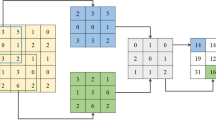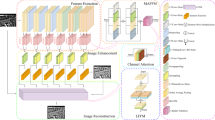Abstract
This study proposes a novel fusion framework for infrared and visual images based on a full convolutional network (FCN) in the local non-subsampled shearlet transform (LNSST) domain. First, the LNSST is used as a multi-scale analysis tool to decompose the source images into low-frequency and high-frequency sub-images. Second, the coefficients of the high-frequency sub-images are fed into the FCN to obtain the weight map, and then the average gradient (AVG) is used as the fusion rule to fuse the high-frequency sub-images while the low-frequency coefficients are fused by local energy fusion strategy. Finally, the inverse of the LNSST is applied to obtain the final fused image. The experimental results showed that the proposed fusion framework performed better than other typical fusion methods in both visual quality and objective assessment.










Similar content being viewed by others
References
Bai X (2016) Morphological center operator based infrared and visible image fusion through correlation coefficient[J]. Infrared Phys Technol 76:546–554
Bavirisetti DP, Dhuli R (2015) Fusion of infrared and visible sensor images based on anisotropic diffusion and Karhunen-Loeve transform[J]. IEEE Sensors J 16 (1):203–209
Bottou L (2010) Large-scale machine learning with stochastic gradient descent[M]. In: Proceedings of COMPSTAT’2010. Physica-Verlag HD, pp 177–186
Cheng B, Jin L, Li G (2018) Infrared and visual image fusion using LNSST and an adaptive dual-channel PCNN with triple-linking strength[J]. Neurocomputing 310:135–147
Glorot X, Bengio Y (2010) Understanding the difficulty of training deep feedforward neural networks[C]. In: Proceedings of the thirteenth international conference on artificial intelligence and statistics, pp 249–256
Han Y, Cai Y, Cao Y et al (2013) A new image fusion performance metric based on visual information fidelity[J]. Inform Fus 14(2):127–135
Hossny M, Nahavandi S, Creighton D et al (2010) Image fusion performance metric based on mutual information and entropy driven quadtree decomposition[J]. Electron Lett 46(18):1266–1268
Jiang Z-t, WU H, Zhou X-l (2018) Infrared and visible image fusion algorithm based on improved guided filtering and dual-channel spiking cortical model[J]. Acta Opt Sin 38(2):112–120
Jin-xi L, Ding-fu Z, Sheng Y et al (2018) Modified image fusion technique to remove defocus noise in optical scanning holography[J]. Opt Commun 407:234–238
Kumar BKS (2015) Image fusion based on pixel significance using cross bilateral filter[J]. Signal Image Vid Process 9(5):1193–1204
Lewis JJ, O’Callaghan RJ, Nikolov SG et al (2007) Pixel-and region-based image fusion with complex wavelets[J]. Inform Fus 8(2):119–130
Li S, Kang X, Hu J (2013) Image fusion with guided filtering[J]. IEEE Trans Image Process 22(7):2864–2875
Li H, Wu XJ, Kittler J (2018) Infrared and visible image fusion using a deep learning framework[C]. In: 2018 24th International conference on pattern recognition (ICPR). IEEE, pp 2705–2710
Li J, Song M, Peng Y (2018) Infrared and visible image fusion based on robust principal component analysis and compressed sensing[J]. Infrared Phys Technol 89:129–139
Liu Y, Chen X, Ward RK et al (2016) Image fusion with convolutional sparse representation[J]. IEEE Signal Process Lett 23(12):1882–1886
Liu Y, Chen X, Peng H et al (2017) Multi-focus image fusion with a deep convolutional neural network[J]. Inform Fus 36:191–207
Liu Y, Chen X, Cheng J et al (2018) Infrared and visible image fusion with convolutional neural networks[J]. Int J Wavelets Multiresol Inform Process 16 (03):1850018
Lu H, Li Y, Mu S et al (2017) Motor anomaly detection for unmanned aerial vehicles using reinforcement learning[J]. IEEE Internet Things J 5(4):2315–2322
Lu H, Li Y, Chen M et al (2018) Brain intelligence: go beyond artificial intelligence[J]. Mob Netw Appl 23(2):368–375
Lu H, Li Y, Uemura T et al (2018) Low illumination underwater light field images reconstruction using deep convolutional neural networks[J]. Futur Gener Comput Syst 82:142–148
Lu H, Wang D, Li Y et al (2019) CONet: a cognitive ocean network[J]. arXiv:1901.06253
Ma J, Chen C, Li C et al (2016) Infrared and visible image fusion via gradient transfer and total variation minimization[J]. Inform Fus 31:100–109
Ma Y, Chen J, Chen C et al (2016) Infrared and visible image fusion using total variation model[J]. Neurocomputing 202:12–19
Ma J, Zhou Z, Wang B et al (2017) Infrared and visible image fusion based on visual saliency map and weighted least square optimiza-tion[J]. Infrared Phys Technol 82:8–17
Serikawa S, Lu H (2014) Underwater image dehazing using joint trilateral filter[J]. Comput Electr Eng 40(1):41–50
Toet A (1989) A morphological pyramidal image decomposition[J]. Pattern Recogn Lett 9(4):255–261
Wang W, Chang F (2011) A multi-focus image fusion method based on Laplacian pyramid[J]. JCP 6(12):2559–2566
Xiang Y, Jun M (2018) Image fusion method based on entropy rate segmentation and multi-scale decomposition[J]. Laser Optoelectron Progress 1:33
Xiang T, Yan L, Gao R (2015) A fusion algorithm for infrared and visible images based on adaptive dual-channel unit-linking PCNN in NSCT domain[J]. Infrared Phys Technol 69:53–61
Xydeas CS, Petrovic V (2000) Objective image fusion performance measure[J]. Electron Lett 36(4):308–309
Yan X, Qin H, Li J et al (2015) Infrared and visible image fusion with spectral graph wavelet transform[J]. JOSA A 32(9):1643–1652
Zhang Q, Guo B (2009) Multifocus image fusion using the nonsubsampled contourlet transform[J]. Signal Process 89(7):1334–1346
Zhang B, Lu X, Pei H et al (2015) A fusion algorithm for infrared and visible images based on saliency analysis and non-subsampled Shearlet transform[J]. Infrared Phys Technol 73:286–297
Zhao C, Shao G, Ma L et al (2014) Image fusion algorithm based on redundant-lifting NSWMDA and adaptive PCNN[J]. Optik-Int J Light Electron Opt 125(20):6247–6255
Zhao W, Lu H, Wang D (2017) Multisensor image fusion and enhancement in spectral total variation domain[J]. IEEE Trans Multimed 20(4):866–879
Zhou Z, Wang B, Li S et al (2016) Perceptual fusion of infrared and visible images through a hybrid multi-scale decomposition with Gaussian and bilateral filters[J]. Inform Fus 30:15–26
Author information
Authors and Affiliations
Corresponding author
Additional information
Publisher’s note
Springer Nature remains neutral with regard to jurisdictional claims in published maps and institutional affiliations.
Rights and permissions
About this article
Cite this article
Feng, Y., Lu, H., Bai, J. et al. Fully convolutional network-based infrared and visible image fusion. Multimed Tools Appl 79, 15001–15014 (2020). https://doi.org/10.1007/s11042-019-08579-w
Received:
Revised:
Accepted:
Published:
Issue Date:
DOI: https://doi.org/10.1007/s11042-019-08579-w




